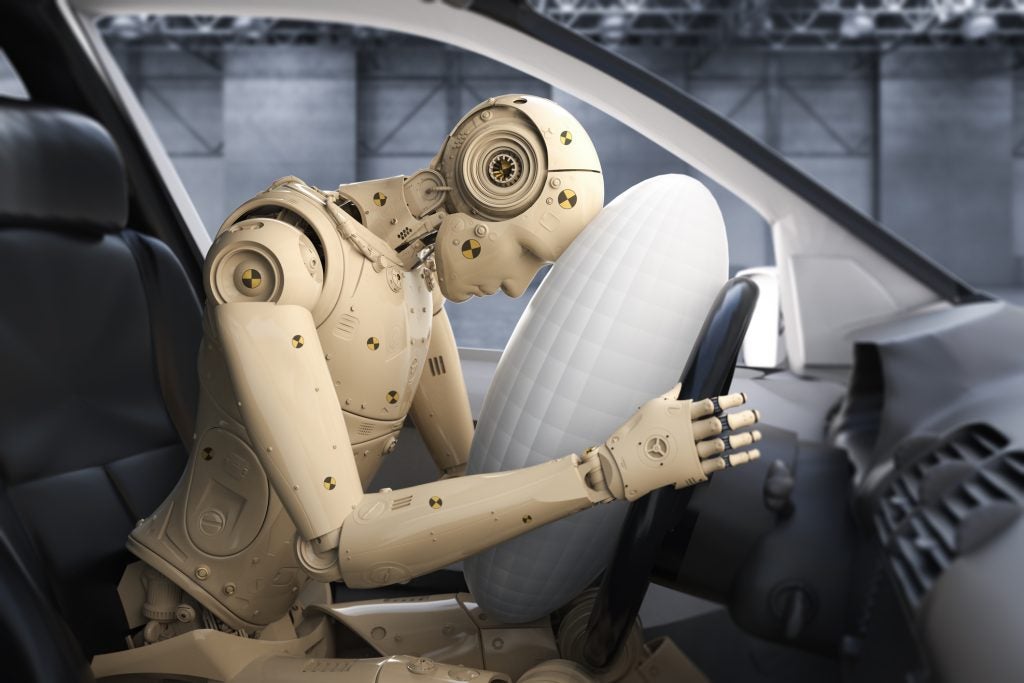The Insurance Institute for Highway Safety once staged a head-on crash test between a 1959 Chevrolet Bel Air and a 2009 Chevrolet Malibu and the results were startling.
Despite having tons of reinforced steel, the ‘59 Chevy was obliterated to the degree that anyone inside the cabin would have been killed instantly. Meanwhile, the ‘09 Chevy was rendered a total loss, but the occupants would likely have walked away with relatively minor injuries.
The video, which went viral on YouTube, shows how far the automotive industry has come in terms of producing safe cars and many of the advances we take for granted have evolved over the years.
Early automobiles had virtually no safety equipment to speak of. Most cars were driven under 25 miles per hour, and so no one felt restraints were necessary.
MORE: MotorHeadline: An automobile as quirky as its architect
Apparently, auto manufacturers didn’t think brakes were that important either. According to Automotive Training Centres, early brakes consisted of two wooden blocks wrapped around the axle. A driver would pull a lever to manually operate the “brake.”
While hydraulic drum brakes evolved over the years, muscle cars of the 1960s were still notorious for brake failure. Due to cost concerns, disc brakes were slowly phased in over the 1970s and 1980s.
The first automobile built with safety in mind was the 1948 Tucker Torpedo. According to the Tucker Auto Club of America, the “Car of Tomorrow” featured innovations such as a pop-out windshield, padded surfaces and an enlarged front passenger “cubby” where the passenger could dive down and take cover in the event of a pending crash.
Curiously, though, the ‘48 Tucker did not come with seatbelts.
According to the Henry Ford Museum of American Innovation, seatbelts were offered in most cars starting in the mid-1950s. The early belts consisted of a lap belt and a separate shoulder belt that was clipped onto the headliner.
The federal government began mandating automakers provide seat belts in 1968, but hardly anyone in the public paid notice.
In 1959, Nils Bohlin, an engineer with Swedish car maker Volvo, developed the now standard three-point safety belt system. According to AAA, Volvo executives realized that Bohlin’s invention could save thousands and thousands of lives. The company decided not to file a patent but make the development free to other car makers.
Even with a user-friendly restraint system, people still would not buckle up, so some manufacturers designed an automated system to force people to strap in. The system was so bulky and bothersome that people simply cut the seatbelt out entirely.
Finally, by the early 1990s, states began to pass seat belt laws, and Georgia finally came around to enacting a law in 1988. New Hampshire is the only state not currently mandating adults wear seatbelts.
Today, the National Highway Traffic Safety Administration estimates 15,000 lives are saved by the three-point harness system.
MORE: Motorheadline: When it comes to cars, it’s best to shop locally

One bit of safety equipment that is often overlooked is the third brake light. When the federal government began to mandate them, most people scoffed that it was just more useless government regulation; however, the third light requirement is rooted in science.
According to the American Psychological Association, in 1974, psychologist John Voevodsky performed an experiment where he fitted some San Francisco cabs with a third light without telling the cabbies and then compared results against a control group of cabs without the third light.
Voevodsky’s conclusion was that the cabs with the extra light suffered 60.6% fewer rear-end collisions; however, it still took 20 years for the third light to become standard equipment.
Modern cars now come with a plethora of safety systems. Automatic headlights, radar driven crash avoidance software, back-up cameras, tempered glass, crumple zones, anti-lock brakes, tire pressure monitoring and, of course, airbags are available, and most are standard equipment.
Only one so-called “safety device” has largely been a flop: the highly touted turn signal system.
This system allows the driver to signal the driver behind them of an impending turn by blinking the car’s taillight. While it seems like a good idea, the steering wheel stalk that operates the system clutters the cockpit and the driver can accidentally engage the system if they are trying to send a text while driving, causing their car to careen down the road with a blinking light that confuses the other drivers.
Also, blinker light fluid is extremely expensive and most auto parts stores no longer even carry it since most drivers have found that flashing their middle finger is a much more convenient way to signal other drivers.
You know that I’m only kidding!
Drive careful, use your turn signal, and don’t text and drive. See you on the road.
Scott Hudson is the senior reporter for The Augusta Press. Reach him at scott@theaugustapress.com










